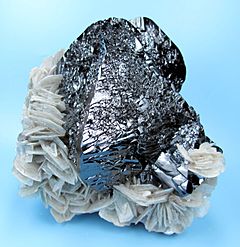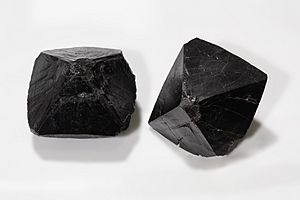Cassiterite facts for kids
Quick facts for kids Cassiterite |
|
|---|---|

Cassiterite with muscovite, from Xuebaoding, Huya, Pingwu, Mianyang, Sichuan, China (size: 100 x 95 mm, 1128 g)
|
|
| General | |
| Category | Oxide minerals |
| Formula (repeating unit) |
SnO2 |
| Strunz classification | 04.DB.05 |
| Crystal symmetry | Tetragonal 4/m 2/m 2/m |
| Unit cell | a = 4.7382(4) Å, c = 3.1871(1) Å; Z=2 |
| Identification | |
| Color | Black, brownish black, reddish brown, red, yellow, gray, white; rarely colorless |
| Crystal habit | Pyramidic, prismatic, radially fibrous botryoidal crusts and concretionary masses; coarse to fine granular, massive |
| Crystal system | Tetragonal - Ditetragonal Dipyramidal |
Cassiterite is a special mineral that is the main source of the metal called tin. It is an oxide mineral, meaning it contains tin and oxygen, with the chemical formula SnO2. This mineral is usually not see-through, but very thin pieces can be translucent, letting some light pass through.
Cassiterite often has a shiny look, called its luster, and can form beautiful crystal shapes. Because of this, some high-quality cassiterite crystals are even used as gemstones or collected by mineral fans. For thousands of years, cassiterite has been the most important ore (rock from which metal can be taken) for getting tin. It still is today!
Where is Cassiterite Found?

Most of the cassiterite we find today comes from alluvial or placer deposits. These are places where rivers or water have washed away rocks over time. The cassiterite grains are very strong and heavy, so they settle in these deposits.
Some of the best places to find cassiterite that is still in its original rock (called primary deposits) are in the tin mines of Bolivia. Here, it is found in special rock veins formed by hot water, known as hydrothermal veins.
Cassiterite is also a small part of many igneous rocks. These rocks are formed when hot, melted rock (magma or lava) cools down. The old mines in Cornwall, England, and the veins in Bolivia, have cassiterite in quartz veins and pegmatites. These are often found near granite rocks. Other minerals like tourmaline, topaz, and fluorite are often found with cassiterite in these places.
Today, major tin production from cassiterite comes from countries like Malaysia, Thailand, Indonesia, parts of Somalia, and Russia. Miners often use hydraulic mining methods to get the ore. This method uses strong jets of water to wash away lighter materials, leaving the heavy cassiterite behind. This works well because cassiterite is quite dense, about 7 times heavier than water.
Images for kids
-
Stalactitic-botryoidal, banded, "wood tin" cassiterite, 5.0 x 4.9 x 3.3 cm, Durango, Mexico
-
Close up of cassiterite crystals, Blue Tier tinfield, Tasmania, Australia
See also
 In Spanish: Casiterita para niños
In Spanish: Casiterita para niños




